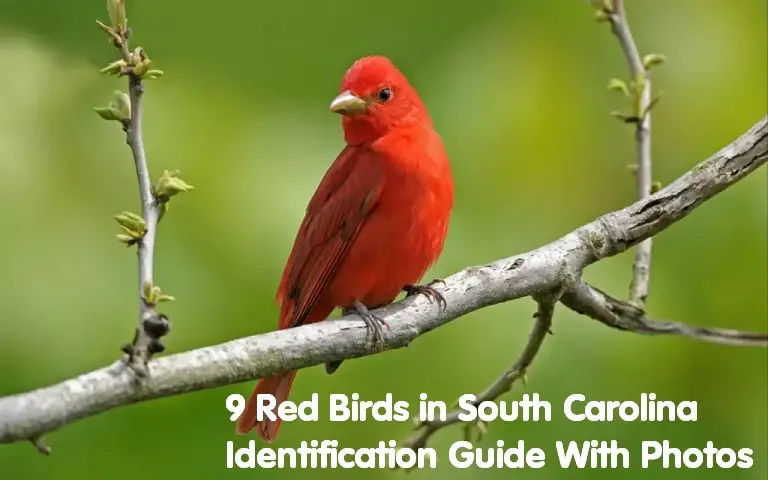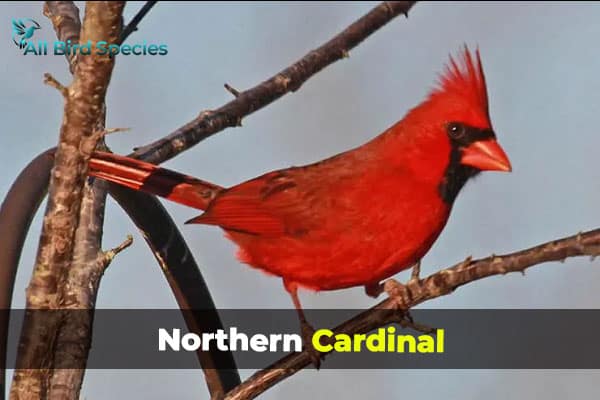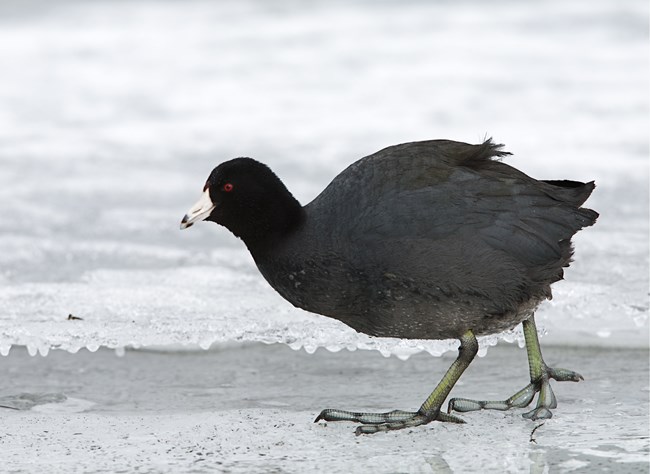9 Red Birds in South Carolina: Identification Guide With Pictures
In South Carolina, several types of red-feathered birds bring life and color to the area. These birds are not just beautiful to look at. They also help the ecology! This article talks about nine types of these red birds. For each one, you’ll learn what they look like, how they act, and how you can find them.
1. Northern Cardinal (Cardinalis cardinalis)
Northern Cardinal is a famous bird, noted for its deep red plumage and tuneful melodies. Males sport a bright red color, while females display more muted tones mixed with dashes of red. These chirpy residents are present through all seasons, typically seen in home gardens, public parks, and woodlands. Their jolly tweets and calls ring in the day, earning them the love of many bird lovers.
Cardinals like seeds, often found at feeders filled with sunflower or safflower seeds. They are also known to guard their area, particularly during breeding season, when males might fight to keep their space. Observing a pair of cardinals is fun; they show kind acts such as feeding one another. Seeing these species is cheerful; they add vibrant red color to the southern scenery.
| Attribute | Details |
|---|---|
| Length | 8.3–9.1 inches (21–23 cm) |
| Weight | 1.5–1.7 oz (42–48 grams) |
| Wingspan | 9.8–12.2 inches (25–31 cm) |
| Habitat | Woodlands, gardens, backyards |
| Diet | Seeds, insects, berries |
| Lifespan | Up to 15 years |
2. Scarlet Tanager (Piranga olivacea)
Take a walk in the woods, and you might just spot the colorful Scarlet Tanager. The males are a striking crimson hue, complemented by black wings and tails. The red birds stand out in South Carolina forests. The females are a more subtle olive-yellow, helping them blend with nature. These birds move around, favoring places with lots of leaves, and they usually make an appearance in the warmer months of spring and summer.
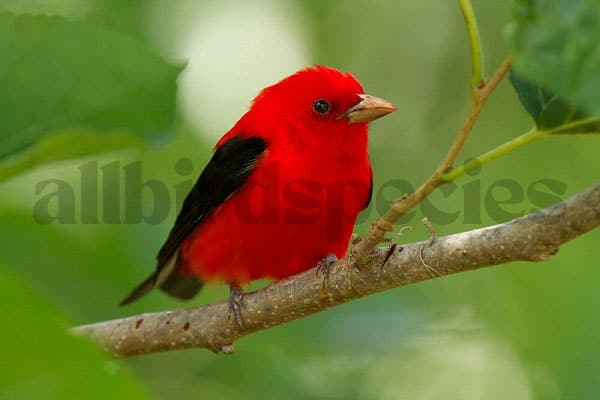
Scarlet Tanagers eat bugs. They love munching on beetles, wasps, and other creepy crawlies, but also enjoy a tasty berry snack. These red birds of south Carolina are super important for keeping pest numbers down, especially in forests. It’s a real treat to spot a Scarlet Tanager out in nature; their bright colors pop against the green surroundings.
| Attribute | Details |
|---|---|
| Length | 6.3–6.7 inches (16–17 cm) |
| Weight | 0.8–1.3 oz (23–38 grams) |
| Wingspan | 9.8–11.4 inches (25–29 cm) |
| Habitat | Deciduous forests |
| Diet | Insects, berries |
| Lifespan | 10–12 years |
3. Summer Tanager (Piranga rubra)
The Summer Tanager is a sight to see in warmer times. Males glow in red, females contrast in yellow-green. They add charm to forests and open woodlands they live in. Often, they sit high in trees, singing songs that boost the summer mood. These migratory birds come to South Carolina in spring and depart by fall.
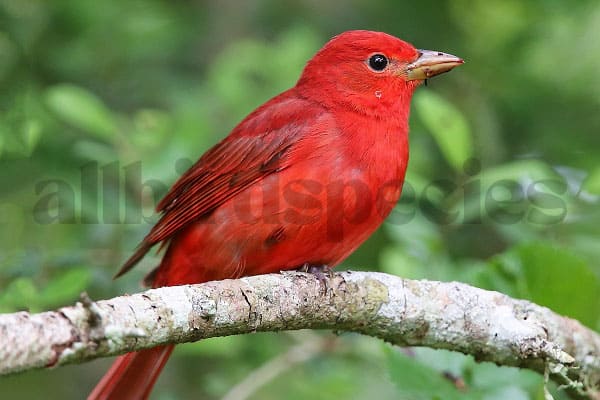
What makes the Summer Tanager especially intriguing is its diet. These birds are expert “bee-eaters,” skillfully snatching bees and wasps mid-flight and removing the stinger before consumption. Their diet also includes various berries, making them vital for seed dispersal in their habitats. Seeing one of these red beauties in action is a thrilling experience for any bird lover.
| Attribute | Details |
|---|---|
| Length | 6.7 inches (17 cm) |
| Weight | 1.1 oz (30 grams) |
| Wingspan | 11–12 inches (28–30 cm) |
| Habitat | Forests, open woodlands |
| Diet | Insects (bees, wasps), berries |
| Lifespan | Up to 5 years |
4. Purple Finch (Haemorhous purpureus)
The Purple Finch isn’t exactly purple. It’s actually more of a bright red, like a raspberry. The males really stand out with red on their heads, chests, and backs. As for female finches, they are brown birds with streaks. This helps them blend in with their surroundings. These finches spend their winters in South Carolina, adding color to the winter landscape. You’ll often spot them near bird feeders, especially if there are sunflower seeds.

Purple Finches are social birds, usually found in flocks that bring life and energy to suburban and rural areas alike. Their cheerful, warbling songs are a joy to hear on quiet mornings. Offering them food in winter not only helps sustain them but also provides birdwatchers with a close-up view of these charming creatures.
| Attribute | Details |
|---|---|
| Length | 4.7–6.3 inches (12–16 cm) |
| Weight | 0.6–1.1 oz (18–32 grams) |
| Wingspan | 8.7–10.2 inches (22–26 cm) |
| Habitat | Forests, gardens, backyards |
| Diet | Seeds, buds, insects |
| Lifespan | Up to 14 years |
5. Painted Bunting (Passerina ciris)
“Rainbow on wings” encapsulates the vivid Painted Bunting beautifully. This bird, one of South Carolina’s most vibrant, wears feathers of red, blue, and green. The ladies? They’re greenish-yellow. Southern coastlines turn into their breeding spots when it’s warm. Where can you find them? Dense shrubs, wooded zones. That’s where they flourish.

Painted Buntings are attracted to bird feeders stocked with millet or sunflower seeds. Their vibrant appearance and timid nature make them highly sought-after by birdwatchers. Observing a Painted Bunting is akin to witnessing a living jewel flitting through the greenery.
| Attribute | Details |
|---|---|
| Length | 4.7–5.5 inches (12–14 cm) |
| Weight | 0.46–0.67 oz (13–19 grams) |
| Wingspan | 8.3–9.1 inches (21–23 cm) |
| Habitat | Shrubs, wooded areas |
| Diet | Seeds, insects |
| Lifespan | Over 10 years |
6. Red-headed Woodpecker (Melanerpes erythrocephalus)
A bold bird called the Red-headed Woodpecker stands out due to its fiery red head, snow-white body, and jet-black wings. It’s interesting that unlike lots of other woodpeckers, the vibrant colors are on both males and females. Widespread in forests, parks, even in city suburbs, they are a common sight throughout South Carolina. Their rhythmic tapping on tree trunks often announces they’re nearby.

These woodpeckers are not only visually striking but also highly resourceful. They store food, such as acorns, for later use, often tucking them into tree crevices. Their omnivorous diet includes insects, seeds, and fruits, making them adaptable to various environments.
| Attribute | Details |
|---|---|
| Length | 7.5–9.1 inches (19–23 cm) |
| Weight | 2–3.2 oz (56–91 grams) |
| Wingspan | 16.5 inches (42 cm) |
| Habitat | Woodlands, parks, backyards |
| Diet | Insects, seeds, fruits |
| Lifespan | 9–12 years |
7. Red Crossbill (Loxia curvirostra)
Check out the Red Crossbill! This bird’s beak has a unique crisscross design, just right for getting seeds out of pinecones. Guys are generally red with dark wings, while girls have olive and yellow colors mixed in. South Carolina’s pine-filled forests are their favorite hangouts. But, they might stop by feeders if they can’t find enough food.

Known for their nomadic behavior, Red Crossbills follow food sources, which can make their appearance unpredictable. Their diet consists primarily of conifer seeds, though they will also eat insects and berries. Watching them use their unique beak to skillfully crack open pinecones is a treat for bird enthusiasts.
| Attribute | Details |
|---|---|
| Length | 5.9–6.7 inches (15–17 cm) |
| Weight | 0.9–1.4 oz (26–40 grams) |
| Wingspan | 9.8–11.8 inches (25–30 cm) |
| Habitat | Coniferous forests |
| Diet | Conifer seeds, insects, berries |
| Lifespan | Up to 8 years |
8. Common Redpoll (Acanthis flammea)
Meet the Common Redpoll, a tiny finch with a bright red forehead and lively personality. You might miss them in South Carolina during the winter, because they usually stick together in groups. Their light-colored feathers, striped brown backs, and red accents add a playful touch to the chillier seasons.

Redpolls are highly adaptable birds, often seen foraging for seeds in weedy fields or visiting feeders during harsh winters. These red birds of south Carolina lively and sociable, constantly chattering and flitting about. Providing nyjer or sunflower seeds in feeders can attract these delightful birds to your yard.
| Attribute | Details |
|---|---|
| Length | 4.5–5.5 inches (11.5–14 cm) |
| Weight | 0.42–0.56 oz (12–16 grams) |
| Wingspan | 7.5–8.7 inches (19–22 cm) |
| Habitat | Weedy fields, forests |
| Diet | Seeds, insects |
| Lifespan | 2 to 3 years |
9. White-winged Crossbill (Loxia leucoptera)
Just like its cousin, the Red Crossbill, the White-winged Crossbill is unique. It has a special beak and a standout look. Boys are mostly red, with black wings showing off big white strips. Girls are less flashy, having a greenish-yellow color. These birds are not seen often in South Carolina, but sometimes they show up in pine woods.

White-winged Crossbills are birds that primarily eat pine seeds. They use their special beaks to unlock cones. Often, they appear in small, chatty groups, babbling as they hop from one tree to another. Their ability to adapt and their interesting eating ways make them a popular choice for bird enthusiasts.
| Attribute | Details |
|---|---|
| Length | 5.9–6.7 inches (15–17 cm) |
| Weight | 0.8–0.9 oz (24–26 grams) |
| Wingspan | 10.2–11 inches (26–28 cm) |
| Habitat | Pine forests |
| Diet | Pine seeds |
| Lifespan | Up to 8 years |
Final Thoughts
You’ll see many different red birds in South Carolina. They makes the place colorful. People who like birds really enjoy them. There’s the brave Northern Cardinal and the roaming Red Crossbill. Each bird is different and important to nature. You could be filling bird feeders at home or walking in the woods. Just look! These beautiful birds might be there!

